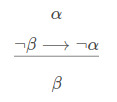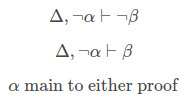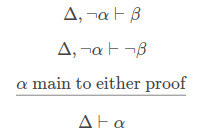#mathematical logic
Text
Why don’t they teach mathematical logic earlier? It’s present in literally all the books you have to read anyway. Some algebra author is going to be like for vs real numbers a,b ≠ 0 there exists a ratio a/b that is also a real number. And most people can’t even read that. Like half of the book is completely inaccessible because logic is fucking wild and requires actual practice with.
I’m not saying that this stuff is incredibly hard; it’s not. However logic just isn’t taught even though it is clearly foundational.
Sets especially seem to trigger me. Like I think a lot of people struggle with trig specifically because this aspect of functions is just not taught well. Like of course the arcsin(x) isn’t defined for -pi/2 > x < pi/2. It would be so much better if we actually taught this stuff.
#pretty frustrated#vent#mathematical logic#math#logic#mathblr#foundational mathematics#the more I read Hammock’s proof textbook#the angrier I get#this should have been taught at the bringing#there is nothing here that requires even algebra
128 notes
·
View notes
Text

PHOTOSTORY DRY AS DUST / SPECIAL EPISODE
the theory of derivation trees
#dry as dust#logic#mathematical logic#TV#Show#TV show#protocephalopod#photostory#comic#Jackie Branc#elloon
5 notes
·
View notes
Note
is mathematics dealing with absolute truth?
That question is really thrilling to answer, to be honest.
We have to define 'absolute truth' first.
If we consider this "absolute truth" as logical consistency, then I'd like to introduce Gödel's Incompleteness Theorems:
Gödel's Incompleteness Theorems, for instance, state that mathematics will never be complete, because it will always have parts that cannot be proven. Either it is incomplete, but consistent, or complete but inconsistent (in form of being self-referent).
Mathematics cannot prove itself by its own rules, WITHIN its own system.
As for another track of thoughts/perspctive: (Now it becomes an utter mess... And I am sorry for leaping between multiple different conceptions rn. My thinking process IS like what I describe here - a sort of "extraction process" of "truth", or correct and exact thoughts. )
The only "absolute truth" there is, is actually that there is none - as a kind of "structure" at least, as in a "static", non-chaotic linear axiomatic system (Classical logic). When it comes to non-linear axiomatic systems [networks] (inserting chaos theory in meta-math - neat feedback-loop INSIDE mathematics as recursive system itself btw) I would rather refer to such "truth" as a process of oscillating around the most exact reality description - the symmetry axis is hence the equilibrium state and the actual structure of absolute truth. But- this is exceeding the margin now - The absolute state is an information singularity I call "invertium". Reaching that equilibrium causes an 'inversion', a process of inner polarity. That recursive inner polarity IS that absolute truth.
Furtherly, I somehow sense a strange logical twisted mindfuck fusing Gödel's Incompleteness with my concepts on non-linear axiomatic [networks] (Quantum logic, in a sense). (Transcendence of a paradox, huh???)
Also, in regards of these trains of thought, "absolute truth" is what I would call a "superposed entangled state of all truths and lies" - like an information singularity. A state in which an Invertium happens - the indistinguishabilty of two extreme states - 100% dense information can't be distinguished from a 0% one. A singularity is hence, in a sense, an isolated [conservative] system itself, from a rough viewpoint.
What happens in this state? I suppose a desintegration of said information as "self/own complex", and integration of its information parts into its super-ordinate medium. (That is how I interpret entanglement) (The information strangely "dissolves"/integrates.)
Absolute truth bears every partial truth - and all partial truths, well, I would refer here to Feynman's Path integrals, virtual pairs in Feynman-diagrams and statistical mechanics.
And I am sorry for the confusion. Maybe one day I will be able to turn these highly compressed thoughts into fathomable chunks.
(In my upcoming book a lot of the concepts stated above will be some of the primary issues.)
#quantaraum#math#mathematics#non linear axiomatic systems#quantum logic#logic#formal logic#meta mathematics#mathematical logic#information singularity#gödels incompleteness theorems#godels incompleteness theorems#truth
46 notes
·
View notes
Text
The Reference System
This Hilbert-style deductive system was shown to me at university, it's carefully designed to have two meta-theorems: Deduction and Reductio-ad-absurdum.
Introduction
The propositions on this system will have two logic operators: Negation (¬) and implication (⟶).
There will be only one rule of inference: Modus Ponens (henceforth M.P.).

The axiom schemata will be:
Antecedent Introduction (henceforth A.I.):

Passing the antecendent (henceforth P.A.):

Modus Tolens (henceforth M.T.):

Before proving T.D. it's necessary to prove reflexivity:

One way to think P.A. is as saying: If α and β prove γ and α proves β, the α on its own can prove γ. α ⟶ α and α prove α through M.P., and α proves α ⟶ α through A.I., so according to P.A. α proves α; in other words, if we have α we have all we need to prove α through M.P.
# Step Reason 0. ( α ⟶ ( ( α ⟶ α) ⟶ α ) ) ⟶ ( ( α ⟶ ( α ⟶ α ) ) ⟶ ( α ⟶ α ) ) By P.A.: φ = α, ψ = (α ⟶ α), τ = α 1. α ⟶ ( ( α ⟶ α) ⟶ α ) By A.I.: φ = α, ψ = α ⟶ α 2. ( α ⟶ ( α ⟶ α ) ) ⟶ ( α ⟶ α ) By M.P. on 0. and 1. 3. α ⟶ ( α ⟶ α ) By A.I.: φ = α, ψ = α ∎ α ⟶ α By M.P. on 2. and 3.
There may be a more strightforward way to prove this but I do not know it.
The Meta-theorem of Deduction
The Meta-theorem of Deduction (henceforth T.D.) consist of the following: If you have a proof of β using a set of premises Δ together with α, you can use it to construct a proof of α ⟶ β using Δ.

Note the following:
Using M.P. you could get γ from β ⟶ γ and β, but what if you wanted to get α ⟶ γ? You could use A.I. and M.P. to get α ⟶ (β ⟶ γ) and α ⟶ β and then use P.A. and M.P. to get α ⟶ γ, you could think of it as first "introducing" α as an antecedent to the premises and the "passing" it to the conclusion.
If in the above case you wanted to "introduce" β as antecedent instead of α, you wouldn't need to use A.I. with β, you could simply remove β and directly use β ⟶ β since reflexivity is a theorem.
So if you have a proof of β using Δ together with α, you can simply "introduce" α as antecedent to all the premises and axioms used in the proof (removing α from the proof in the process) and then "pass it down" the proof until you reach the conclusion as discussed above, if you write all the steps you'll have a formal proof of α ⟶ β from Δ. Here's a more formal proof using induction.
The Principle of Explosion
The Principle of Explosion (henceforth P.E.) consist of the following: If you have α and ¬α you can construct a proof of β, for all α and β.

The proof is constructed using A.I. and M.T. in the following manner:
# Step Reason 0. ¬α Premise 1. ¬β ⟶ ¬α Using A.I. and M.P. on 0. 2. α ⟶ β By M.T. and M.P. on 1. 3. α Premise ∎ β By M.P. on 2. and 3.
The Meta-theorem of Reductio-ad-absurdum
The Meta-theorem of Reductio-ad-absurdum (henceforth R.A.) consist of the following: If you have a proof of β and ¬β using the set of premises Δ together with ¬α, you can prove α using Δ.

Let's say γ is a premise of Δ or a theorem.
Using P.E., you can construct a proof of ¬γ using β and ¬β as premises.
Since there's a proof of β and a proof of ¬β both using Δ and ¬α as premises, you can join these two proofs with the one above into a proof of ¬γ using as premises Δ and ¬α.
We can use T.D. on that proof to construct a proof of ¬α ⟶ ¬γ using Δ.
Since γ either belongs to Δ or is a theorem, we can use M.T. and M.P. on ¬α ⟶ ¬γ to conclude α; appending these steps to the previous proof we get the proof of α from Δ, which is what we wanted.
#math#maths#mathematics#logic#formal logic#mathematical logic#propositional logic#deduction#mathonmain
3 notes
·
View notes
Text
FOL+Nat?
So, First Order Logic (FOL) can’t uniquely specify the natural numbers. There are non-standard models of first-order arithmetic.
Is there maybe a way to talk about like, “First order logic, except that we have access to the standard model of arithmetic”? And like, talk about what structures can be uniquely defined in FOL+(access to standard model of arithmetic) ?
I suspect the answer is yes.
(By “standard model of arithmetic” I mean standard model of the natural numbers, so, not including negative integers, not that it particularly matters which one I meant.)
So, like, I’d think that in such a “FOL+Nat” there would be a way to uniquely define the integers, the rationals, etc. These would only be uniquely defined given the standard model of the natural numbers, but I think that would be enough in many cases.
I guess one could define it as just like,
“A theory in FOL+Nat consists of a theory in FOL which has the theory of first order arithmetic as a designated part of it, and a model of such a theory in FOL+Nat is a model of the theory such that when restricted to the sort that represents the natural numbers, is the standard model of the natural numbers.”
That seems like it should work fine?
I think it should work fine.
One question then, would be, how does the Löwenheim–Skolem theorem (which says that for any countable first-order theory, if it has an infinite model, then it has a model of every infinite cardinality), change when we look at, instead of models of theories considered as theories in FOL, instead look at models of theories considered as theories in FOL+Nat ? Can we classify the “theories in FOL+Nat which have exactly one model”? (Where, “only one model” means in the sense of “a model of a theory in FOL+Nat, not in the sense of “a model of a theory in FOL”, which is to say, it only counts if the part of the model which is modeling the part of the theory which is first-order arithmetic, is the standard model of arithmetic.)
So, this is asking, essentially, “what theories in FOL which include first-order arithmetic as part of them, would uniquely specify a model, under the assumption that the natural numbers in the model are the standard natural numbers?” .
It would be cool if the answer was “basically most of the ones that you would want.” , but I suspect that may be a little too optimistic. But, it does seem likely enough that the answer is, “oh, lots, and many of the ones you would want.” .
But, I haven’t really taken a class or anything on this kind of topic so my intuition there could easily be wrong.
2 notes
·
View notes
Text
I have a difficult exam (non-classical logic) tomorrow and I'm fretting over every single thing that I might forget so I wanna put down the biggest thing that I constantly forget:
- T principle enforces reflexivity onto a modal kripke frame.
- B principle enforces symmetry onto a modal kripke frame.
- D principle enforces being serial onto a modal kripke frame: every node has a successor.
- 4 principle enforces transitivity onto a modal kripke frame.
- 5 principle enforces being euclidean onto a modal kripke frame.
- Lob (or Gödel-lob) principle enforces the modal kripke frame to be transitive and conversely well-founded: it is transitive (the 4 principle holds) and has no absolutely increasing infinite chains.
The three types of soundness in modal logic: at the level of a node (model and labels constant), at the level of the model (model constant, labeling constant but covers all the atoms appearing in the nodes), and frame (unlimited choice of labeling function
A normal logic is a logic that contains all the classical logic tautologies, the K principle, modus ponens and necessitation results, plus a principle which might limit the models it might have.
That's all for now, thanks.
1 note
·
View note
Text
Ancient Egyptian Chemical Science
When did science start? To answer that, you have to ask, what is the scientific method? My answer to that is you start by observing something, and when you work out what you think made it happen, you try to use it with something else. After you have found a number of successes, you start to induce a hypothesis. Essentially, you have a set of observations, and a rule that conveys set membership.…
View On WordPress
#ancient trade#antibacterial#embalming chemicals#induction#mathematical logic#metalworking#natron#pigments#scientific method
1 note
·
View note
Text
Unknowing
Publisher: In-Sight Publishing
Publisher Founding: November 1, 2014
Web Domain: http://www.in-sightpublishing.com
Location: Fort Langley, Township of Langley, British Columbia, Canada
Journal: In-Sight: Independent Interview-Based Journal
Journal Founding: August 2, 2012
Frequency: Three (3) Times Per Year
Review Status: Non-Peer-Reviewed
Access: Electronic/Digital & Open…

View On WordPress
0 notes
Text
It's so funny to me that people think of Math/Mathematicians as being hyper-logical and rational. Like, have you seen some of the wild things hiding in the Math?
Did you know there are non-computable numbers?? (https://en.wikipedia.org/wiki/Chaitin%27s_constant)
Did you know that there are things that are true, but we can't prove them??? (https://en.wikipedia.org/wiki/G%C3%B6del%27s_incompleteness_theorems)
Did you know that we can prove that something exists, and yet never actually figure out what that thing is?? (https://mathworld.wolfram.com/NonconstructiveProof.html)
Math is crazy. Math is wild. Math hardly makes sense, and when you think you understand the weirdest parts of it, everyone who hears you explain it to thinks you're a gibbering lunatic.
"In mathematics you don’t understand things. You just get used to them." - von Neumann
(please share more unhinged math with me, i want to see more scary math)
#stem#math#mathblr#academics#mathematics#logic#stemblr#academia#proofs#computer science#theoretical computer science
2K notes
·
View notes
Text
Easy way to find the centre of the board if it’s not an even number.
#science#mathematics#maths#Pythagoras theorem#math#logic#educational#pro tip#life hack#pythagorean theorem#Pythagoras' theorem#top post
36K notes
·
View notes
Text
Mathematics people interested in either learning about the Peano axioms of natural numbers (how do you prove a+b = b+a) or interested in learning a proving assistant (Lean) should DEFINITELY check out the natural number game. This is a game which teaches you both of these things step by step, and has you construct the natural numbers and their most important properties from the very basic axioms. Even if you just like logical puzzles and are interested in a bit of mathematics you should check it out!
574 notes
·
View notes
Text
who's hand is in this picture?

A Mathematically Rigorous Proof That I Spent Too Long Writing
welcome to university math: dnp hand edition
(no, don't leave, you'll be fine i promise)
to begin, we need a statement to prove. we have two options:
- the hand is dan's hand
- the hand is phil's hand
now, for most proofs in university math, you are told a true statement, and you must show why it is true using logic rules, definitions, and theorems. but, we do not know which of these statements are true, so we have to find out.
to prove that a statement is true, we must show that it is always true for the situation presented. to show a statement is false, we must present a single instance where the statement is false (also known as a counter example).
a quick not scary math example:
definition: a prime number is only divisible by 1 and itself.
statement: all prime numbers are odd
(this is false, because 2 is a prime number and it is even. you don't even need to check if there's any others, all you need is one single case where it isn't true to disprove it)
so now that we have a little background on proofs and how to prove and disprove them, we go back to our two statements.
the thing with this situation is, one of them must be true (unless you're gung-ho on someone else holding dan's face while phil takes a picture on his phone of dan in his glasses, in which case, i applaud your commitment, but in actuality this proof will cover that option too)
the full statement we have is: dan is touching his face or phil is touching dan's face
now, because this is Real Life and we have a picture where a hand is touching dan's face, we know already that one of these options is true (as mentioned above) but! using symbolic logic you could also come to this conclusion.
this type of statement is an 'or' statement, and if you're curious, you can look into 'truth-tables' and see why, but at least one of the options must be true.
back to the proof at hand (bah-duhm-tss)
okay. now, proofs also must be 'general' in order to mean anything, really. these are statements of truth of the universe, not just for individuals. so, we will prove this generally.
we have 2 people involved, so individual 1 (dan, the owner of the face and potential face toucher) will be labelled as 'D' , and individual 2 (phil, the possible face toucher who does not own the face) will be labelled as 'P'. thus, this can be true for any such D and any such P.
so with our 'or' statement, in order to prove it, we pick one of the options and say that it is not true, and we have to show then that the other is true.
step 1: let's assume this is not P's hand. (assumption)
step 2: thus, it must be D's hand. (what we take from our assumption)
step 3: now, if it is D's hand, we look at what a hand on one's own face is capable of appearing like. (a definition or true fact about step 2)
the position in the given photo shows the hand with a thumb on the cheek, and a finger on the forehead. so, we find an example of a person with their fingers in the same position (or close to) and see if this supports our claim.
consider:

now, with this image, you can clearly see how the subject's right hand has the thumb on the temple and index finger on the top of their head, however, it is a close enough position for our case.
from the view of the camera, the closest finger to the camera is the edge of the pinkie. in fact, it will always be the closest finger to the camera in this position, assuming the subject has all fingers and no additional appendages.
step 4: we now compare this to our photo (we verify if this holds to our claim or contradicts it)

in our photo, the closest appendage to the camera is the edge of the thumb.
step 5: thus, it cannot be the case that D is touching their own face. (what the evidence says)
step 6: as we assumed it was not P's hand and have shown it cannot be D's hand, and as this is an 'or' statement both of these claims cannot be false, we can therefore conclude it must be P's hand. (our conclusion: re-stating the statement and assumptions and conclusion)
step 7: we verify that P is true (optional step but in beginner proofs you generally show why your case works)
to do this, i will show a picture of a person touching another's face, and compare it to our image.
consider:

now, this image is not exactly the same, similar to above. however, P's left thumb is on the cheek, with their index on D's temple. the closest appendage to the camera (if it were in a similar perspective as our original) would be the edge of the thumb.
comparing it to our original:

our comparison holds.
thus, we can conclude that the true claim in this statement is that P must be touching D's face, which, in particular means that:
phil is touching dan's face in the image
thank you for partaking in phannie mathematics. we now know. i am not sorry.
bonus:
phil has a hitchhikers thumb and dan doesn't so why was this necessary at all 🤡


#genuinely might be my magnum opus#please don't be scared of the math there's not numbers if anything it's more logic than what most people would know as math#this was purely for fun. my brain just saw the anatomical options while ive been staring at that photo since we've gotten it#dan looks sooo good in phils glasses and i cant not think about it yknow#dan and phil if you read this. hi. hope you enjoyed the math lesson. loved the video btw. thank you for wdapteo 2023.#also shout out to all my other math major phannies. love you. hope you enjoyed#dnp#c.text#dan and phil#and for the hell of it:#math#mathematics#math proof
190 notes
·
View notes
Text

Ambigram depicting Gödel's Incompleteness
So I played bit with concepts and words, and somehow I could manage to depict main aspects of Gödel's Incompleteness in that ambigram.
A simplified version of Gödel's incompleteness theoreoms:
A recursive axiomatic system is either inconsistent and complete, due to proving itself with its own rules - hence, being self-referent and thus inconsistent, or it is consistent, but incomplete, due to not being proven.
#gödels incompleteness theorems#godels incompleteness#incompleteness#logic#mathematical logic#formal logic#metamathematics#meta mathematics#math#mathematics#inconsistent#paradox#oxymoron#contradiction#pleonasm#tautology#transcendence of a paradox#parody of paradoxes
24 notes
·
View notes
Text
A Deductive System with Reductio-ad-Absurdum and without Principle-of-Explosion (maybe)
It's possible (maybe) to have Reduction-ad-Absurdum (RA) without a Principle-of-Explosion (PE).
I will show a deductive system (what’s that?) for propositional calculus (what’s that?) with the former and (probably) not the latter.
I will base this new system in (another one), henceforth The Reference System. The Reference System has antecedent introduction (AI) and Modus Tollens (MT) and therefore a PE; I’m going to weaken the PE by removing antecedent introduction:

One of the problems is that in The Reference System, AI is used in the proof of the Meta-theorem of Deduction (TD), moreover, a system with conventional TD and the conventional definition of proof WILL have antecedent introduction (proof); therefore, the new system will need a different, weaker, Meta-theorem of Deduction (wTD).
Weak Meta-theorem of Deduction
First of all, Let’s us consider a proof (what’s that?) as a set of binary trees (what’s that?) with the following characteristics:
The nodes of the trees are propositions.
At least one of the trees must have the conclusion as root, we will call this the “main tree”.
The leaves of any given tree must be either a premise or an axiom.
The parent of two nodes can be obtained by them using the system’s rule of inference, Modus Ponens (MP).
Note that:
Not all premises may be in the proof
There may be trees other than the main tree.
This is because you don’t need to include all your premises in your proof, or you can include them but don’t use them, or use them to prove propositions you don’t latter use.
Let’s say we have a proof, If α is a premise (or axiom) in the main tree of the proof and ω is the conclusion, we need an algorithm to construct a proof of α ⟶ ω , using the premises in the set Δ except α, if we do we will have wTD:

Let’s us assume α is used only once as a premise, since α is in the main tree of the proof, there’s a path from α to ω; we will “add” α as an antecedent to α, then to the next node in the path, then to next and so forth, until we “add” it to ω.
We will need reflexivity as an axiom schema:

The first step of the algorithm is to remove α in the proof and replace it with α ⟶ α using reflexivity, “adding” α as an antecedent to α and eliminating the need for it as a premise.
The following steps are to “add” α as an antecedent to the next node on the path, said node will be the parent of the current one, let’s call it γ, and so obtained from it through MP.
There are two cases: Either the current node is β or the current node is β ⟶ γ. In the first case we will need the Hypothetic Syllogism (HS) as an axiom schema:

With it and MP we have:

Which we can use to “add” the antecedent to γ. In the second case we will need Commutativity-of-Antecedents (CA) as an axiom schema:

With it an MP we have:

After, we can do MP to “add” the antecedent to γ. We continue like this until we add the antecedent to ω thus obtaining the new proof we sought.
It’s possible that in the original proof α is used as a premise more than once, in that case there will be a path from each instance of α to ω which will eventually converge, in that case the algorithm needs to be applied along each path and a new axiom schema (Idempotency) will be needed:

With it an MP we have:

This is because when two paths converge, after using CA and HS we will get:

Idempotency with MP will eliminate the additional antecedent.
The wTD thus proven is weaker in the sense that you can only turn a premise or axiom into an antecedent if it’s part of the main tree of a proof, in that case we will call them a main premise of a proof, a main axiom of a proof or simply main.
Meta-theorem of Reductio-ad-Absurdum
Before going further, I will add as axiom schemata Double Negation Introduction (DNI):

And Double Negation Elimination (DNE):

And add or remove double negations without care (proof that I can).
*In The Reference System, DNI and DNE were proven using Reductio-ad-Absurdum, since this system is weaker, at least one of them needs to be introduced as an axiom schema, which of them depends on the version of MT used.
Next, we will need MT as an axiom schema:

And with MP we get:

Adding MT results in a mini Principle-of-Explosion (mPE):

If α is main in a proof of β instead of ¬β you can use DNI on β and proceed similarly.
Essentially, if we have a main premise or main axiom of a proof, disproving the conclusion would disprove them as well.
Let’s say Δ together with ¬α prove β and ¬β with α being main in the proof of at least one of them:

By the mPE we have that Δ together with ¬α proves ¬γ , γ being either in Δ or an axiom, and main to the proof of either β or ¬β:

Since α is main in the proof of either β or ¬β, it’s also main in the proof of not γ, so we can use wTD and then, since γ it’s either in Δ or an axiom we can use MT to prove α.

Thus justifying the use of weak Reductio-ad-Absurdum (wRA):

Informally, the whole argument is this: if by assuming α is essential to conclude β and ¬β, then one of our main premises or axioms doesn’t hold, if we say all of them except α hold, then α must not hold.
Discussion
The normal reasoning of RA is: if α proves β and ¬β then α proves everything including the negation of theorems and therefore α doesn’t hold; here we are using β and ¬β as a sufficient argument that α doesn’t hold even if that wouldn’t result in a proving every other proposition.
Going back to mPE, in order for it to become a full PE:

β would need to be a main premise of a proof of either α or ¬α, for all α and β.
Having PE or not reduces to having Antecedent Introduction (AI) or not, since with antecedent introduction, this system would be equivalent to The Reference System (proof) and therefore have PE. Likewise, if we have PE we could prove AI (proof).
It’s possible AI could be proven in this system, after all, if The Reference System is consistent with AI so is this one. To truly prove that this system has no PE, it is necessary to prove it is consistent with the negation of antecedent introduction; I have no idea how to prove that.
#math#maths#mathematics#logic#formal logic#mathematical logic#paraconsistency#paraconsistent logic#principle of explosion#propositional logic#deduction#mathonmain
0 notes
Text
Rate your favorite logic notation
#math notation#logic#math#maths#mathematics#mathematical operators#mathblr#foundations#computer Science
333 notes
·
View notes
Text
Hot concept for an isekai:
The protag is a math undergrad and they're dropped in the world of their logic professor's textbook
Everyone is either wearing unidentified colored hats or in prison
#isekai#induction puzzle#logic puzzle#math meme#math memes#maths meme#maths memes#mathematics#math#maths
213 notes
·
View notes